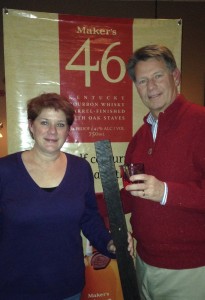If you have procrastinated (like the GrogDog has with her New Year’s Eve post) and are looking for last-minute party cocktails for New Year’s Eve or New Year’s Day, try a champagne cocktail bar! All you need are sparkling wine (which includes prosecco, champagne, or any other wine with bubbles) and a few basic additions. Chill the wine, put the juices and liqueurs on a long table, buffet-style, and let your guests mix their own festive concoctions!
The traditional Champagne Cocktail is made from Angostura bitters, a sugar cube, and sparkling wine. Put the sugar cube in the bottom of a champagne flute, soak it with a few drops of bitters, and top with the wine. (If you’re feeling particularly fancy, add a lemon twist as garnish.)
The Mimosa is a basic sparkling cocktail made with orange juice (a Tablespoon or two, to your taste) in a flute, topped with sparkling wine.
The Kir Royale is similar to a Mimosa, but uses Chambord raspberry liqueur in place of the orange juice. (A traditional Kir uses creme de cassis instead of Chambord, in case you’re curious.)
Working off these three basic cocktails, you can offer guests choice of flavors from ingredients you may already have, or can easily obtain.
This is a good time to reach to the back of the bar and dust off any fruity or herbal/botanical liqueurs you have on hand. Curacao, Chambord, and other fruit-based liqueurs will add flavor and in some cases bright color to your sparkling cocktail. Herbal liqueurs like St-Germain (elderflower), Domaine de Canton (ginger), and Chartreuse (made from a secret herb recipe) can be an acquired taste, but are delicious ingredients if you like those flavors.
You can also offer a selection of fruit juices, like pomegranate, cranberry, pineapple, and orange or blood orange so your guests can enjoy variations on the Mimosa. Don’t forget to pick up sugar cubes and Angostura bitters for those who want a traditional Champagne Cocktail!
The great thing about the champagne cocktail bar is that you can set one up without spending a lot of time or money.
It’s not worth splurging on an expensive sparkling wine when it’s going to be mixed with liqueurs or juices, which will affect the taste and texture (amount of bubbles). Prosecco – Italian sparkling wine – is generally inexpensive and slightly sweet, so it’s a great choice for mixing. In my experience, however, Prosecco has “softer” bubbles than French or American sparklers, so if you’re looking for something with a lot of fizz, go for the California sparkling wines.
For more on how the bubbles get into the wine, and which methods are used for which type of sparkling wine, check this Wiki entry.
Happy New Year from GrogDogBlog!



 This week’s TGIF cocktail of the week is the Pisco Sour! While
This week’s TGIF cocktail of the week is the Pisco Sour! While 